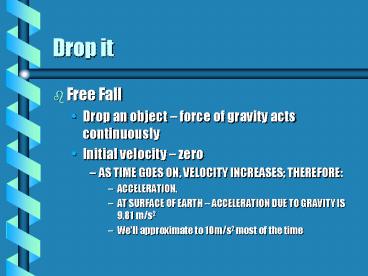Free Fall PowerPoint PPT Presentation
1 / 17
Title: Free Fall
1
Drop it
- Free Fall
- Drop an object force of gravity acts
continuously - Initial velocity zero
- AS TIME GOES ON, VELOCITY INCREASES THEREFORE
- ACCELERATION.
- AT SURFACE OF EARTH ACCELERATION DUE TO GRAVITY
IS 9.81 m/s2 - Well approximate to 10m/s2 most of the time
2
Drop it
- Free Fall
- Drop an object force of gravity acts
continuously
Galileo Galilei born 1564 Argued in his time
that In a vacuum, where there is no air
resistance, all bodies fall at the same rate
regardless of mass/weight
3
Drop it
- Galileo rolled balls down inclined planes with
gradually increased angles. - Why not just drop from a building??
- Clocks in the 1500s???
- He slowed things down with a shallow inclined,
then extrapolated to 90o - The acceleration was always proportional
4
Drop it
- We will ignore air friction
- Lets look at 10 m/s per second squared
5
Drop it
- Drop object -- at what speed will the object be
every second of travel? - elapsed time speed
- 0 0
- 1 10
- 2 20
- 3 30
- etc
6
Drop it
- Rate of change of speed
- 10 m/s every second
- Not only falling, but on the way up, also.
- Throw an object up, it will decelerate at the
rate of 10 m/s every second.
7
Drop it
- Speed at any time
- vat
- get this from a ?v / ?t
- Since acceleration due to gravity is constant
free fall speed - vgt, where g is acceleration due to gravity
8
Drop it
- Every second of travel, how far does the object
fall? - Between 0 and 1 second what is average speed?
Starts 0, ends in 10 m/s. So - 0 plus 10 divided by 2 5m/s
- How far? V x/t x vt (5 m/s)(1 s) 5 m
- Between 1 and 2 seconds of fall, what is average
speed? - 10m/s plus 20m/s divided by 2 15 m/s
- X vt (15 m/s)(1 sec) 15 m plus 5 m at 1
sec - 20 meters
9
Drop it
- Elapsed Time Distances Fallen
- o o
- 1 5
- 2 20
- 3 45
- 4 80
- etc.
10
Drop it
- Kinematic
Which comes from
11
Drop it
12
Work it out . . . . .
13
(No Transcript)
14
Terminal Velocity
- Terminal Speed increases as the objects weight
increases, and - Decreases as its cross-sectional area increases.
- Galileo wrote
- A cannon ball weighing one or two hundred pounds,
or even more, will not reach the ground by as
much as a span ahead of a musket ball weighing
only half a pound, provided both are dropped from
a height of 200 cubits.
15
Terminal Velocity
- Terminal speed of a child is less than that of an
adult. - Small animals and insects surviving falls that
are immense in proportion to their size - How can we survive a hail storm?
- . . . . . Air friction saves us.
- Hailstones hit earth at 25 30 km/hr
- If air friction ignored, what would speed be if
hail left a cumulonimbus cloud at 9.144 x 103 m?
--
424 m/s .. Or 947 mph!
16
Record Free Fall
Lieutenant I. Chisov of former Soviet Union
- Ilyushin 4 January 1942
- Attacked by 12 German Messerschmitts
- Plane damaged beyond survival, so he bailed out
at 21,980 ft - Rather than be a sitting duck . . . . .free fell
- Wanted to pull rip cord at 1000 ft, but
- Passed out and hit edge of steep ravine at 120
mph with 3 ft of snow slid along bruised and
sore - SURVIVED WITH JUST A FEW BONE INJURIES
17
(No Transcript)

